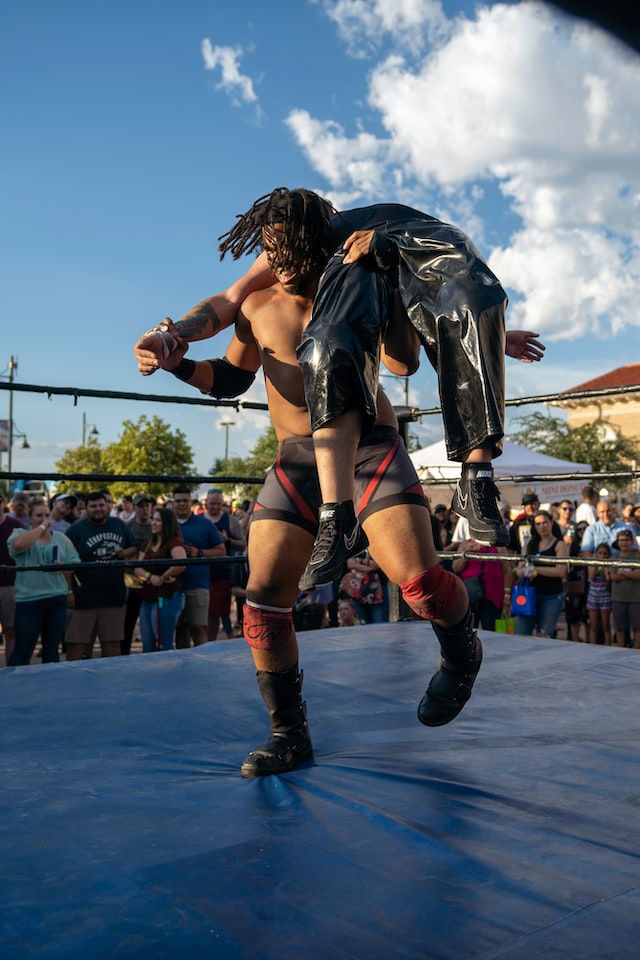Now that that’s clear, let’s not forget Game of Thrones wasn’t real either. Most things on TV aren’t real.
What pro-wrestling is, is a unique mix up of athleticism, melodrama, soap opera, and comic books brought to life. Larger than life characters waging intense battles over pride, revenge, jealousy, greed, and other baser emotions, but also a huge range of fan favorites (babyfaces in the backstage parlance) to uphold righteousness, each in their own unique way. In the end, all of them want the same thing: to prove themselves the best, and hold the most prestigious of championships.
Like comic book characters, the stars do battle with fists, punishing technical holds, aerial moves that would wow Olympic gymnasts, not to mention the brutal “hardcore” style that involves swinging “steel” chairs, diving off ladders and even “hitting” people with sledgehammers. In some wrestling companies (commonly called federations), even staple guns are considered legal when a true blood feud must finally be settled.

Unlike comic characters, these performers are very real. Their true lives and their characters weave together and blur, as reality enters the storylines, as recently happened when a couple involved in a bitter feud on camera, got engaged and posted it on Instagram. It couldn’t be ignored, an abrupt change to the script had to be made. Unlike comic characters, real life injuries, or other unforeseen issues can derail months of story planning in a heartbeat. Often, the performers are so deeply associated with their characters that people approach them on the street as if they were that character. See, wrestling may not be real, but it requires incredible physical talent and is very, very painful, even when things go right.
Since wrestling traces its history back to the dawn of the past century (Mexican federation Consejo Mundial de Lucha Libre started in 1933!) and many companies have ran for decades. Even outside these federations, as workers move from company to company, stories spread across the entire wrestling world. It’s not uncommon for federations to slag their competition right on the air. A wrestler may work with another in an American company one year, a Japanese the next, and be in Mexico just months later. Feuds blow up, end, flare up, simmer, or boil, literally every show. All that history makes for a never-ending story played out in real time. Wrestler debut, rise or fall, learn, grow, shine or flop, spend their career in the best places they can go then retire, some day, possibly to return as a manager or even on-screen owner, GM, and many more.
Once, in World Wrestling Entertainment, or WWE, formerly WWF, Samoan wrestler Rikishi confronted the late, great “Rowdy” Roddy Piper over an incident between Piper and Jimmy Snuka that had happened over a decade prior. One of the most complex characters and longest lasting role (or gimmick in industry terms) ever created is The Undertaker. Undertaker started as some sort of Wild West zombie mortician, yet still managed to endure for over thirty years. He’s the holder of the most impressive streaks in the pseudo-sport, 21 straight wins at the biggest annual show in wrestling, Wrestlemania. Amazingly, he’s still wrestling today at 54 years old. He’s not even the oldest wrestler working today.
Wrestling’s popularity has faded in the past 20 years. It’s become more of a niche market show. WWE has its own speciality cable channel, where they air their biggest, and smallest, shows. Commercial television remains their biggest exposure source. WWE alone produces over ten hours of programming a week. So big the shows are split into three separate brands and rosters. A recent deal to move one of the biggest shows, Smackdown, to FOX will only open a wider audience than their other major shows, which air on USA Network. WWE love to remind you their flagship show, RAW, is the longest running, weekly, episodic, television show in history, and Smackdown is #2. While that’s true, in terms of number of episodes, it’s also a lot of caveats to throw at a record.
Wrestling is not going anywhere. There is enough pro wrestling available in the modern day, one could easily fill their entire TV watching schedule and nothing else. While we’re not recommending that, it seems wrestling isn’t going anywhere. WWE’s current slogan is “Then. Now. Forever.”
Wrestling can also be a launching point to bigger and better things. In the 50s, wrestling legend “Classy” Freddie Blassie was so famous he appeared on “I Love Lucy.” 80s star Hulk Hogan is a household name. Dwayne “The Rock” Johnson is one of the biggest stars in Hollywood; and 2000s star John Cena is starting to break out in a similar way.
Getting started watching any wrestling program can seem overwhelming. Huge casts, multiple storylines, and the history mentioned above, can be a lot to absorb. It’s possible wrestling itself is responsible for its loss in popularity. The time investment can be off-putting. Soap operas demanded that level of commitment; they’ve fared even worse than wrestling in terms of audience drops. The difference is wrestling survives, and might even be entering a New Renaissance.
Everyone should watch wrestling once, preferably a major show. The pure spectacle of it all is worth the time. And, if it catches your heart and the kid inside you, you too may find yourself among the “marks” in the stands.


